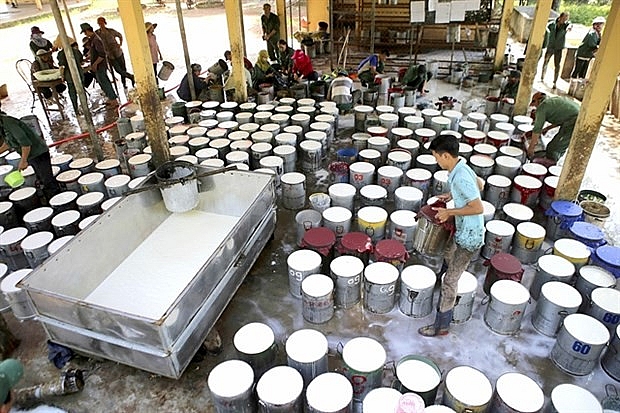
Rubber industry needs to develop production chain
Latest
 |
| Rubber latex of the Quang Tri Rubber Co Ltd. Viet Nam's rubber industry needs to develop its production chain to meet the increasing demands of export markets. (Photo: VNA) |
To Xuan Phuc, an expert of Forest Trends, said Viet Nam's export of processed rubber has been increasing to many countries. However, Viet Nam's export rubber products must meet many requirements on the export market, including legal issues.
At present, Viet Nam has exported latex and refined rubber products to 175 countries and territories and this figure is continuing to expand.
Viet Nam's largest export market for rubber products was the US, reaching about 1 billion USD in 2020, with a market share of 33.2 percent, followed by Japan, China, the Republic of Korea and Germany.
However, there is a situation that the amount of rubber harvested from small farms is higher than that of large rubber plantations, according to Phuc.
Therefore, the Vietnamese rubber industry needs to make changes in the future to meet the market requirements.
The industry needs to be transparent about the production supply chains, including information about supply and chain activities.
According to Tran Thi Thuy Hoa, an expert from the Rubber Research Institute of Viet Nam, small rubber farms have become one of the most important parts in the rubber industry. Especially, in the production of natural rubber, small rubber farms' supply has accounted for over 60 percent of the total output of natural rubber. However, small rubber farms have been developed mainly by spontaneity.
Small households have sold latex mainly via traders without recording enough information about transactions among them.
Therefore, there is a lack of information from all stages of the supply chain, including information on links between households and the traders, meaning a failure to meet the requirements of export markets.
This reduces opportunities for the households and businesses to access the market, but also creates risks for the Vietnamese rubber industry when entering the export market in the future, according to Hoa.
On the other hand, the market's tendency to require legal and sustainable products is inevitable in the future, so Viet Nam's rubber industry must comply with the market requirement.
According to Viet Nam Rubber Association, in 2020, Viet Nam's export value of natural rubber reached over 2.38 billion USD, accounting for 30.3 percent of the total export value of the rubber industry.
Export value of processed rubber products was about 3.11 billion USD in 2020, accounting for 39.6 percent. Rubber wood exports were 2.36 billion USD, accounting for 30.1 percent.
Export turnover of natural rubber and rubber products of Viet Nam has increased in recent years.
Viet Nam has the fifth largest rubber area growing rubber trees in the world, but its output ranked third, only after Thailand and Indonesia.
It has exported mainly raw material of latex accounting for about 78.4 percent. The rest (21.6 percent) has been processed products such as tires, gloves, accessories and soles of shoes.
























